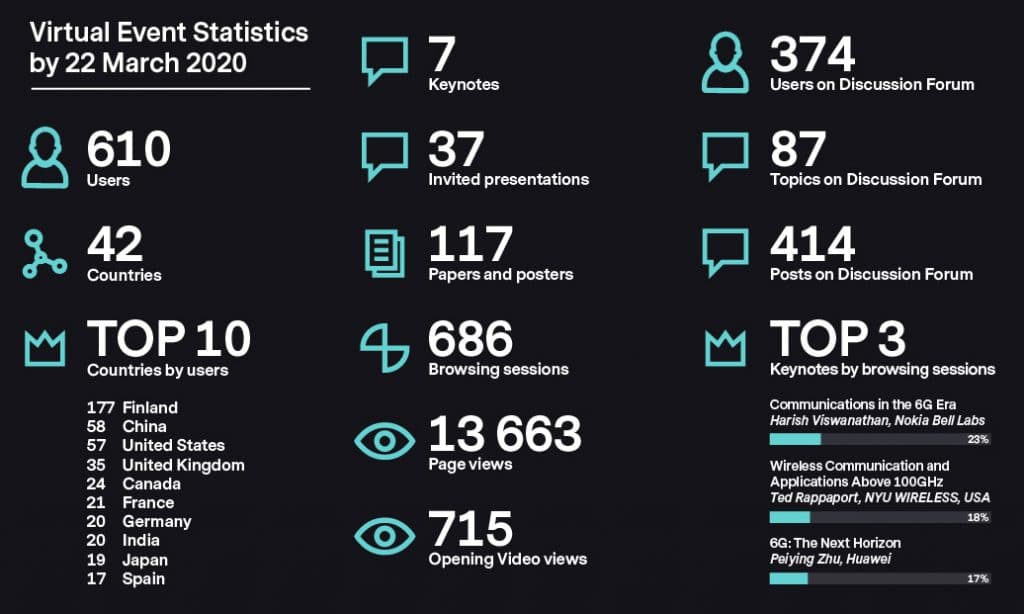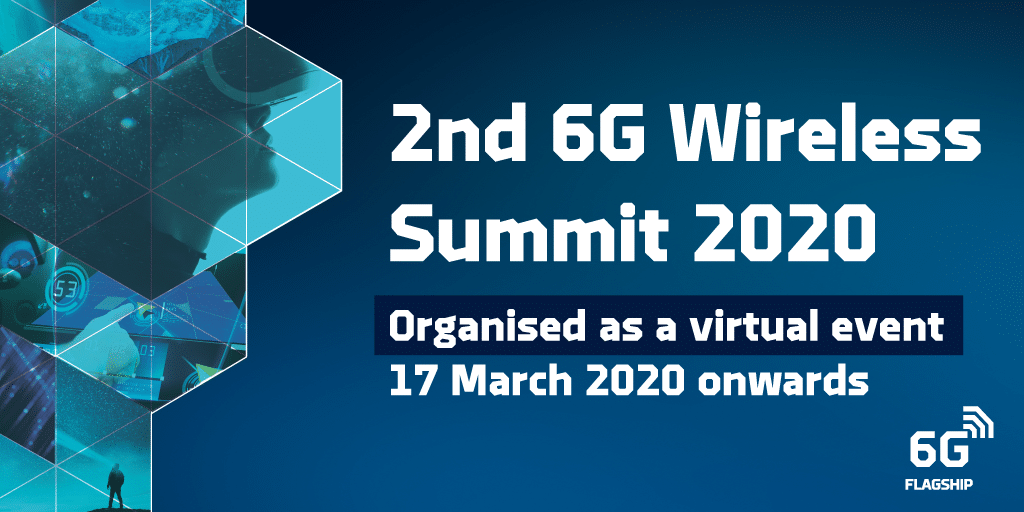
Path towards 6G Clarified at the Virtual 2nd 6G Wireless Summit 2020
As the World Health Organisation (WHO) declared COVID-19 a pandemic and the world began to go into lockdown, the organisers of 2nd 6G Wireless Summit 2020 decided to transform the leading global 6G event to a virtual one – in less than five days. Sharing of 6G visions, research results and challenges could be realised virtually, the organising team in the Finnish 6G Flagship programme concluded.
Attending a virtual event, the more than 400 registered participants could stay safe in their homes or offices while having online access to a total of 161 presentations: 7 keynotes, 37 invited presentations including 20 recorded videos and 10 slide presentations with audio, 75 technical papers including 29 recorded videos and 45 slide presentations with audio, and 42 posters. In addition, the presented papers would gain a wide global audience even before their publication in IEEE Xplore.
The virtual event was launched in the morning of 17 March 2020, as originally planned for the physical event. “It was made possible by a seven-member team including students, technical staff and myself as technical programme committee chair,” said Nandana Rajatheva. “We worked nearly around the clock in a highly time-constrained scenario as we also wanted to ensure a high-quality outcome.”
Until now, very few major events organised with technical support by IEEE – world’s largest technical professional organisation – have taken place online. “We have received positive feedback from different parts of the world stating that this was truly a landmark achievement leading the world towards other similar events realised virtually,” Rajatheva said.
The turnout left no questions about the timeliness of the discussed topics as 610 experts from 42 countries explored the online material. The website tool and browsers caused some challenges, for sure, but the statistics (below) demonstrate a strong participation. Each presentation also has its own discussion forum and there are also general forums. All registered participants were able to create topics, raise questions and answer them. In six days, by 22 March, experts had written as many as 414 posts in 87 topics.

At the same time, the entire 2nd 6G Wireless Summit 2020 website, including both public and protected content, has attracted 18 683 page views in 3 694 sessions since 17 March with an average session duration of 8 minutes 28 seconds.
Academy professor Matti Latva-aho, general chair of the 2nd 6G Wireless Summit 2020 and director of 6G Flagship programme, concluded that the virtual event was a success and it showed how much progress has been made around the globe. “Industry actors have clearly formed their own 6G visions which was a major advancement from last year,” Latva-aho said. “In the Summit, industry representatives expressed their views on the timing of 6G development in relation to upcoming World Radiocommunication Conferences (WRC). In the course of next years, 6G community will focus on the research of enabling technologies and 6G Requirement Specifications as an integral part of the International Telecommunication Union (ITU) process.”
Patrons of the 2nd 6G Wireless Summit were Ericsson, Huawei, ZTE, Keysight Technologies, Nokia Bell Labs, Rohde&Schwarz, Virginia Diodes, InterDigital and Wipro. All patrons were very active in different programme roles, contributing to keynotes, invited talks as well as Q&A sessions. The patrons also extended their thanks to organising the event successfully. However, one disadvantage with the virtual event realisation were the live exhibitions, which unfortunately had to be cancelled. “Exhibition materials in high quantities already arrived in Levi, but we sadly had to return them all back to their origins,” said Tuomo Hänninen who was in charge of organising the exhibitions.
The technical programme of 6G Wireless Summit was both versatile and thought provoking. The organisers were pleased to see that experts were starting to speak out about possible 6G indicators and responding to societal challenges with a more optimistic and daring tone which was a major leap from their more cautious approach in the first 6G Wireless Summit held in Levi, Finland in March 2019.
The suggested indicators not only measure the performance of future 6G systems, but assess novel societal and value-related aspects such as trust, open collaboration, flexibility and underserved areas while a strong emphasis was also put on value creation through new business models and private networks, among others.
The role of imaging and sensing, as integrated functions in 6G networks, was also highlighted in numerous presentations. Experts shared somewhat aligned visions of integrated communication, imaging and sensing in 6G systems towards 2030 where the Internet of Senses will reshape human-machine interaction and where interconnected digital twins for both physical beings and environments will be a norm.
Major investments for 6G research and development were also discussed. The European Commission has taken initiative proposing carbon neutrality by 2050. “It’s huge task and we will be expected, when we develop our 6G technology, whatever domain is, 6G or other any type of domain, to contribute to this carbon neutrality objective,” said Bernard Barani, Deputy Head of Future Connectivity Systems Unit at the European Commission, in his invited talk. He also stressed that there is a very strong political momentum behind 6G developments in Europe. Under the next Horizon Europe programme for 2021-2027, the Commission has proposed more than 2.5 billion € of EU investment matched with at least 7.5 billion € of private investments to prepare for 6G.

Clarifying both 6G research visions and a wide array of views on most intriguing 6G development challenges and paths, the event achieved its goal. Although the virtual space at 6gsummit.com/virtual-event could hardly compete with the winter wonderland in Levi, Lapland, it came with other benefits. Participation was flexible and attendees could focus more intensively on their specific topics of interest. The pre-recorded video presentations provided more insights than mere slides and papers in Proceedings ever could. Last, but not least, the online forum gave even the more silent attendees a voice by providing equal opportunities for in-depth conversation while also producing more elaborated exchange of ideas than speedy Q&As in regular conference sessions.
An absolute highlight at the event were the live Q&As by all seven keynote speakers in the discussion forum which defied the restrictions of time zones. The live Q&A sessions attracted a lot of attention and provided the virtual summit attendees an opportunity to directly interact with the leading experts. Although the full proceedings and discussion forum will remain in the unique use of registered experts and paper authors for a full year, the wider research community can also start benefitting of the Summit’s outcomes. Videos of keynote presentations are openly published on the event website today.
Work on essential 6G research topics continues in twelve 6G white paper groups led by 6G Flagship experts. Final draft White Papers will be published already at the end of April 2020 and final polished White Papers in June 2020.
Other means of following research progress and innovations at 6G Flagship is to explore its novel 6G Waves Magazine and to order the next issues.
6G enthusiasts should also mark in their calendars PIRMC’21 that 6G Flagship will organise on 13-16 September 2021 in Helsinki, Finland. The event will focus on 6G driving sustainability as announced by Matti Latva-aho in the virtual 6G Wireless Summit opening video (below).
“Some parts of the event may be realised virtually, also to promote sustainability,” Latva-aho notes. “This is of course something to be discussed with IEEE Communications Society. The results of our virtual 6G Wireless Summit 2020 certainly support this possibility. And with plenty of time to prepare for PIMRC’21, who knows what exciting virtual novelties we can come up with.”